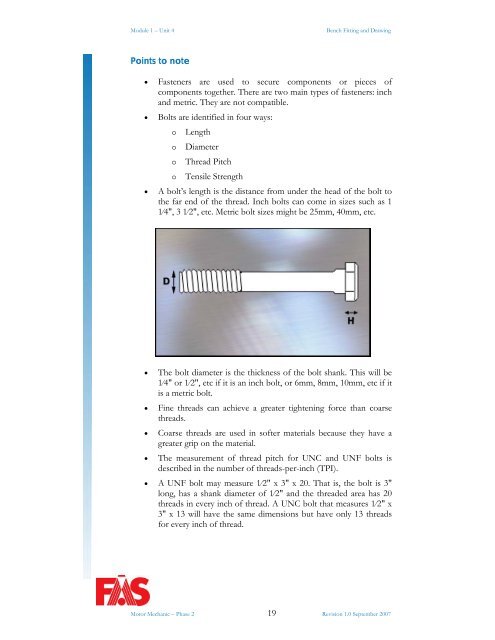TRADE OF HEAVY VEHICLE MECHANIC - eCollege
TRADE OF HEAVY VEHICLE MECHANIC - eCollege
TRADE OF HEAVY VEHICLE MECHANIC - eCollege
You also want an ePaper? Increase the reach of your titles
YUMPU automatically turns print PDFs into web optimized ePapers that Google loves.
Module 1 – Unit 4 Bench Fitting and Drawing<br />
Points to note<br />
• Fasteners are used to secure components or pieces of<br />
components together. There are two main types of fasteners: inch<br />
and metric. They are not compatible.<br />
• Bolts are identified in four ways:<br />
o Length<br />
o Diameter<br />
o Thread Pitch<br />
o Tensile Strength<br />
• A bolt’s length is the distance from under the head of the bolt to<br />
the far end of the thread. Inch bolts can come in sizes such as 1<br />
1⁄4", 3 1⁄2", etc. Metric bolt sizes might be 25mm, 40mm, etc.<br />
• The bolt diameter is the thickness of the bolt shank. This will be<br />
1⁄4" or 1⁄2", etc if it is an inch bolt, or 6mm, 8mm, 10mm, etc if it<br />
is a metric bolt.<br />
• Fine threads can achieve a greater tightening force than coarse<br />
threads.<br />
• Coarse threads are used in softer materials because they have a<br />
greater grip on the material.<br />
• The measurement of thread pitch for UNC and UNF bolts is<br />
described in the number of threads-per-inch (TPI).<br />
• A UNF bolt may measure 1⁄2" x 3" x 20. That is, the bolt is 3"<br />
long, has a shank diameter of 1⁄2" and the threaded area has 20<br />
threads in every inch of thread. A UNC bolt that measures 1⁄2" x<br />
3" x 13 will have the same dimensions but have only 13 threads<br />
for every inch of thread.<br />
Motor Mechanic – Phase 2 19 Revision 1.0 September 2007
















